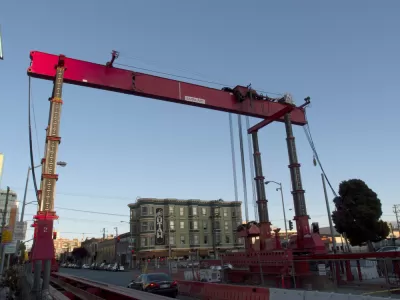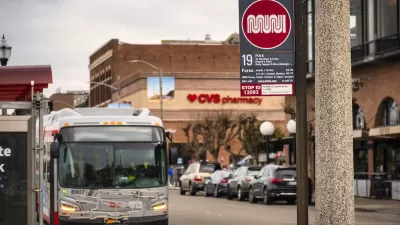Critics of the subway project argue that the line is too short and disconnected from other transit options to be useful. Meanwhile, projected costs continue to rise.

Writing in Mission Local, Joe Eskenazi criticizes San Francisco’s Central Subway, a project decades in the making that Eskenazi believes is taking valuable resources from San Francisco Muni. According to Eskenazi, “the price tag for this project has more than tripled; the final cost is now tabbed at upwards of $1.9 billion, and will all but certainly be significantly higher than that.” Yet “Muni is a system with infinite needs and finite resources. And this is how it’s spending them.”
As the article puts it, “If the Central Subway was a good and useful project, no one would remember the inveterate delays or obscene cost overruns.” However, Eskenazi argues that “it’s exceedingly difficult to overstate how poorly designed this subway line is,” pointing to early designs that failed to include air ducts (now corrected) and platforms designed to only accommodate two-car trains, the subway’s most egregious mistake, according to Eskenazi.
It’s O. Henry-like in its tragic irony: The ridership capacity that would have justified this multi-billion dollar project is now impossible to achieve. Even if people flock to take this rail line, two-car trains will quickly fill up and be overwhelmed.
“This rail line is essentially an orphan, and its failure to be a step toward establishing a true subway network represents a spectacular missed opportunity for San Francisco.” The article quotes architect and Central Subway opponent Howard Wong, who believes the agency is pouring too much money into a project that will serve relatively few riders. “If just the local matching funds for large projects were invested in the overall Muni system, San Francisco would have a more robust transit system today.”
FULL STORY: The Central Subway will cripple Muni for years to come

Planetizen Federal Action Tracker
A weekly monitor of how Trump’s orders and actions are impacting planners and planning in America.

Maui's Vacation Rental Debate Turns Ugly
Verbal attacks, misinformation campaigns and fistfights plague a high-stakes debate to convert thousands of vacation rentals into long-term housing.

Restaurant Patios Were a Pandemic Win — Why Were They so Hard to Keep?
Social distancing requirements and changes in travel patterns prompted cities to pilot new uses for street and sidewalk space. Then it got complicated.

In California Battle of Housing vs. Environment, Housing Just Won
A new state law significantly limits the power of CEQA, an environmental review law that served as a powerful tool for blocking new development.

Boulder Eliminates Parking Minimums Citywide
Officials estimate the cost of building a single underground parking space at up to $100,000.

Orange County, Florida Adopts Largest US “Sprawl Repair” Code
The ‘Orange Code’ seeks to rectify decades of sprawl-inducing, car-oriented development.
Urban Design for Planners 1: Software Tools
This six-course series explores essential urban design concepts using open source software and equips planners with the tools they need to participate fully in the urban design process.
Planning for Universal Design
Learn the tools for implementing Universal Design in planning regulations.
Heyer Gruel & Associates PA
JM Goldson LLC
Custer County Colorado
City of Camden Redevelopment Agency
City of Astoria
Transportation Research & Education Center (TREC) at Portland State University
Jefferson Parish Government
Camden Redevelopment Agency
City of Claremont





























